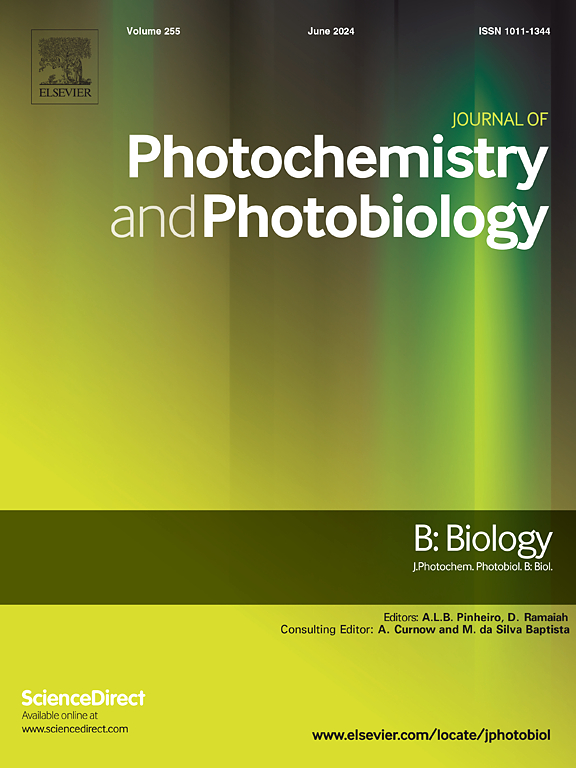aPDT activity of new water soluble phenalenone derivatives with shifted UV–Vis absorption
IF 3.7
2区 生物学
Q2 BIOCHEMISTRY & MOLECULAR BIOLOGY
Journal of photochemistry and photobiology. B, Biology
Pub Date : 2025-03-31
DOI:10.1016/j.jphotobiol.2025.113152
引用次数: 0
Abstract
Antibacterial therapy is one of the most important medical developments of the 20th century, but several decades of antibiotic misuse and abuse have created a health emergency. Antibiotics resistance and ineffectiveness have spread through the community, threatening the enormous gains made by the availability of therapies.
The emergence of drug-resistant infections has encouraged research community to develop new mechanisms against bacterial infections, mainly focused on multi-target strategies like “Antibacterial Photodynamic Therapy (aPDT)”, where singlet oxygen (an excited state of oxygen) is able to oxidize a wide range of biomolecules including proteins, lipids and nucleic acids, leading to bacterial death. Singlet oxygen oxidative damage in aqueous media is restricted by its short diffusion range, around 150 nm. It is crucial to increase photosensitizer solubility in aqueous media keeping the capability of partition in apolar media (like membranes).
We have previously demonstrated that an alkoxy substitution in position 6 of phenalenone scaffold (6-alkoxy-PNF) promotes a bathochromic shift of UV–Vis absorption when compared to clean phenalenone, (with maximum absorption wavelength centered at around 430–450 nm depending on the solvent). Their quantum yields of singlet oxygen generation remained high, in most media.
To take advantage of the photo-physical properties of 6-alkoxy-PNF framework, increase solubility in water and promote attractive electrostatic interaction on the bacterial surface, a trimethylammonium group was introduced in the molecule. Moreover, depending on the length of methylene chain included, hydrophilic lipophilic balance of molecules can be tuned. This substitution through a methylene linker would maintain distance from the 6-alkoxy-PNF, keeps almost unchanged their visible absorption bands (displaced to the red) and their singlet oxygen generation capacity.
Their ability to generate singlet oxygen and hence inactivate bacteria was tested. Our results show that the behavior of this family of compounds is dependent on the length of the alkyl chain, particularly in micro-heterogeneous systems. Synergic effect can be attributed to 12C surfactant associated with antimicrobial surfactant ability and singlet oxygen generation.

紫外可见吸收转移的新型水溶性苯烯酮衍生物的aPDT活性
抗菌治疗是20世纪最重要的医学发展之一,但几十年来抗生素的误用和滥用已经造成了卫生紧急情况。抗生素耐药性和无效已在整个社区蔓延,威胁到治疗方法可获得性所取得的巨大成果。耐药感染的出现促使研究界开发对抗细菌感染的新机制,主要集中在“抗菌光动力疗法(aPDT)”等多靶点策略上,其中单线态氧(一种激发态氧)能够氧化包括蛋白质、脂质和核酸在内的多种生物分子,导致细菌死亡。单线态氧在水介质中的氧化损伤受限于其较短的扩散范围,约为150 nm。提高光敏剂在水介质中的溶解度,保持在极性介质(如膜)中的分配能力是至关重要的。我们之前已经证明,与清洁的苯烯酮相比,苯烯酮支架(6-烷氧基- pnf)的6位烷氧基取代促进了紫外-可见吸收的显色位移(根据溶剂的不同,最大吸收波长在430-450 nm左右)。在大多数介质中,单线态氧生成的量子产率仍然很高。为了利用6-烷氧基pnf框架的光物理性质,提高其在水中的溶解度,并促进细菌表面的吸引静电相互作用,在分子中引入了一个三甲基铵基团。此外,根据所含亚甲基链的长度,分子的亲水亲脂平衡可以调整。这种通过亚甲基连接剂的取代将保持与6-烷氧基- pnf的距离,保持它们的可见吸收带(移至红色)和单线态产氧能力几乎不变。测试了它们产生单线态氧从而灭活细菌的能力。我们的研究结果表明,这类化合物的行为取决于烷基链的长度,特别是在微非均相体系中。协同效应可归因于12C表面活性剂与抗菌表面活性剂能力和单线态氧生成有关。
本文章由计算机程序翻译,如有差异,请以英文原文为准。
求助全文
约1分钟内获得全文
求助全文
来源期刊
CiteScore
12.10
自引率
1.90%
发文量
161
审稿时长
37 days
期刊介绍:
The Journal of Photochemistry and Photobiology B: Biology provides a forum for the publication of papers relating to the various aspects of photobiology, as well as a means for communication in this multidisciplinary field.
The scope includes:
- Bioluminescence
- Chronobiology
- DNA repair
- Environmental photobiology
- Nanotechnology in photobiology
- Photocarcinogenesis
- Photochemistry of biomolecules
- Photodynamic therapy
- Photomedicine
- Photomorphogenesis
- Photomovement
- Photoreception
- Photosensitization
- Photosynthesis
- Phototechnology
- Spectroscopy of biological systems
- UV and visible radiation effects and vision.

 求助内容:
求助内容: 应助结果提醒方式:
应助结果提醒方式:


